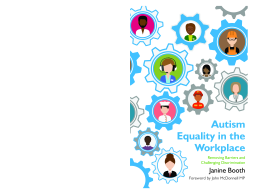
Additional Information
Book Details
Abstract
Neurodiversity in the workplace can be a gift. Yet only 15% of adults with an autism spectrum condition (ASC) are in full-time employment. This book examines how the working environment can embrace autistic people in a positive way.
The author highlights common challenges in the workplace for people with ASC, such as discrimination and lack of communication or the right kind of support from managers and colleagues, and provides strategies for changing them. Setting out practical, reasonable adjustments such as a quiet room or avoiding disruption to work schedules, this book demonstrates how day to day changes in the workplace can make it more inclusive and productive for all employees.
Autism in the Workplace is intended for any person with an interest in changing working culture to ensure equality for autistic people. It is an essential resource for employers, managers, trade unionists, people with ASCs and their workmates and supporters.
In this book, Janine Booth takes a refreshing look at the employment of autistic people through using a social model of disability to analyse how working environments can change to make the most out of autistic employees...this book contains very useful insights into common problems faced by autistic people in the workplace, as well as practical strategies for helping with them. Problems cited range from a lack of understanding from colleagues, to inappropriate support from managers. The author goes beyond the concept of reasonable adjustments however, and suggests that society needs to ask fundamental questions about how the work is organised. This book will be of interest to all who want to work toward making society, and workplaces in particular, more autism-friendly. I would highly recommend it to employers, politicians, researchers, and of course autistic people and their families.
Damian Milton
Aspergers United
This book is essential reading for all those who want to challenge discrimination faced by workers with autism. Janine Booth is an active trade unionist and so her book is packed with practical advice and information that union reps, and autistic workers, need to improve working lives. Workers are better off in a trade union and this book will help make sure that this is true too for autistic workers.
Frances O’Grady, General Secretary of the Trade Union Congress
This must-have resource is a revelation: full of practical tips and examples that present an exciting new approach to dealing with autism in the workplace.
Asha Wije, Head of Employment, UnionLine
Autism Equality in the Workplace has a new employment perspective on autism, which promises to bring out the best in everyone. This book is both a call to action and a highly practical guide to taking effective action. It's useful, entertaining, informative and easy to read.
Dr Dinah Murray, Coming Out Asperger: Diagnosis, Disclosure and Self-Confidence and Getting IT: Using information technology to empower people with communication difficulties
Janine Booth is a workplace trade union representative and Co-Chair of the TUC Disabled Workers' Committee. She is autistic, and has an autistic son, and is a walking advertisement for autism in the workplace. Janine wrote the TUC Disabled Workers' Conference policy on Autism in the Workplace and runs training events for the Workers' Educational Association and for trade unions.
Table of Contents
| Section Title | Page | Action | Price |
|---|---|---|---|
| Autism Equality In The Workplace | 3 | ||
| Foreword | 7 | ||
| Acknowledgements | 9 | ||
| Poem: Manifesto from Behind the Mask | 10 | ||
| Introduction | 13 | ||
| Chapter 1 - Autism in the Workplace | 16 | ||
| Myths or realities? | 19 | ||
| Applying the social model of disability to autism | 25 | ||
| Chapter 2 - Ten Barriers in the Way of Autistic Workers | 30 | ||
| 1. Getting work | 30 | ||
| 2. Getting on with the job | 35 | ||
| 3. Communication | 36 | ||
| 4. Social interaction | 39 | ||
| 5. Sensory issues | 43 | ||
| 6. Organising work | 45 | ||
| 7. The trouble with managers | 46 | ||
| 8. Bullying, harassment, discrimination | 51 | ||
| 9. All change! | 54 | ||
| 10. Job insecurity in a time of austerity | 55 | ||
| Chapter 3 - Remove those Barriers! | 61 | ||
| 1. Getting work | 61 | ||
| 2. Getting on with the job | 67 | ||
| 3. Communication | 73 | ||
| 4. Social interaction | 75 | ||
| 5. Sensory issues | 83 | ||
| 6. Organising work | 86 | ||
| 7. The trouble with managers | 89 | ||
| 8. Bullying, harassment, discrimination | 91 | ||
| 9. All change! | 93 | ||
| 10. Job insecurity in a time of austerity | 94 | ||
| Chapter 4 - Autism, Work and the Law | 96 | ||
| A global convention for rights | 96 | ||
| European Union | 97 | ||
| United Kingdom | 98 | ||
| United States of America | 99 | ||
| Canada | 99 | ||
| Australia | 100 | ||
| Ten key legal concepts | 100 | ||
| Chapter 5 - Organising for Change | 109 | ||
| A progressive workplace policy | 111 | ||
| Collective bargaining and trade unions | 111 | ||
| Nothing about us without us | 116 | ||
| References | 119 | ||
| Subject Index | 123 | ||
| Author Index | 128 | ||
| Blank Page |
